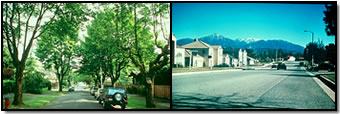Designing Safe Streets and Neighborhoods
Several local jurisdictions are striving to make pedestrians a priority by improving sidewalks, slowing traffic, making crosswalks more visible… the more typical response to concerns about pedestrian safety is to remove crosswalks and let pedestrians fend for themselves.
– Caught in the Crosswalk, 1999
Many of our streets and avenues — even in residential neighborhoods — are not safe to walk or ride on because they are designed solely to move motor vehicles in large volumes and at high speeds. As a result, a disproportionately large number of pedestrians are killed and injured in California and across the nation each year. Children and seniors, the most vulnerable users of streets and sidewalks, are often at greatest risk.

This fact sheet (PDF, 728 KB) examines how poor planning lies at the root of this problem and discusses how we can design streets and neighborhoods that are safe for cars, pedestrians and cyclists.
Designing Safe Streets and Neighborhoods (PDF, 728 KB).
A color hard copy can be requested by calling the Local Government Commission at 916-448-1198, or 1-800-290-8202.
This project is funded by the Physical Activity and Health Initiative, California Department of Health Services under a Preventive Health Services Block Grant from the US Centers for Disease Control and Prevention. Work performed as part of a UC San Francisco contract.
